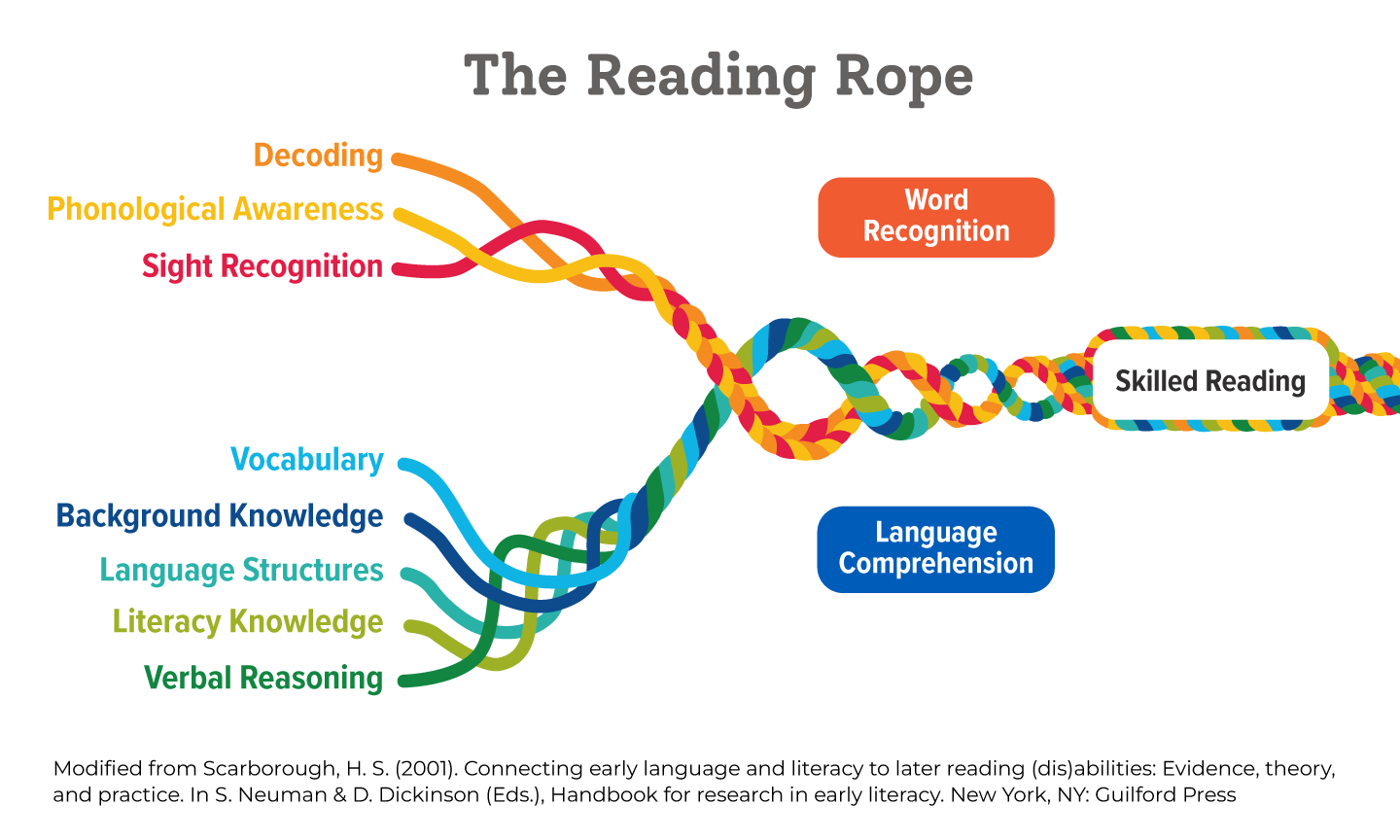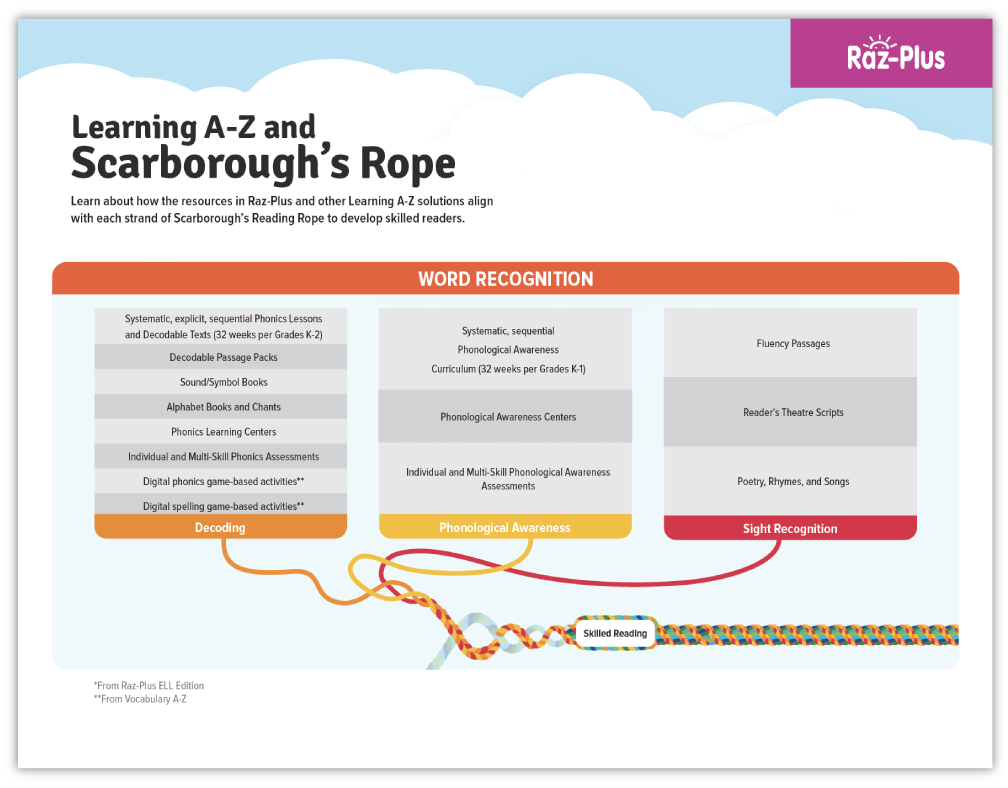A senior scientist at Haskins Laboratories, Hollis Scarborough conceptualized the famous Reading Rope in 2001, reshaping the way educators think about reading skills. She needed a three-dimensional illustration to help parents understand the complexities of learning to read. The Reading Rope she designed is composed of lower and upper strands representing two areas of learning: Word Recognition and Language Comprehension. Intertwined, the strands must reinforce each other and work concurrently with practice over time to result in skilled reading.
What is the Reading Rope?
This visual depiction illustrating the interconnected components of reading acquisition, demonstrated by crucial elements woven together, serves as a useful tool for educators. Its strands can help determine best practices for reading instruction, supporting development in readers at every level throughout various stages of learning. These strands act interdependently through practice and explicit instruction to progress toward the goal: proficient readers.

How are the strands of the Reading Rope used?
- The Word Recognition strand refers to decoding, sight recognition, and phonological awareness, all abilities students must build to achieve fluency, automaticity, and accuracy.
- The Language Comprehension strand encompasses vocabulary, verbal reasoning, language structures, background knowledge, and other literacy skills, enabling students to glean meaning from what they read.
How do Raz-Plus resources align to each strand of the Reading Rope?
Raz-Plus resources support both strands of the rope, working to build word recognition skills and language comprehension for readers at every level. Here are a couple of examples to help you get started:
- To support the Decoding strand, you’ll need resources that give students the chance to apply their knowledge of letter-sound relationships, including letter patterns, to correctly pronounce written words. Raz-Plus Phonics Lessons & Decodable Texts for Grades K-2 provide 32 weeks of systematic, sequential, explicit phonics instruction for introducing, teaching, and practicing letter-sound correspondences, with multisensory instruction addressing phonemic awareness, isolated decoding, and application with connected text. Decodable Passages Packs reinforce phonetic concepts for Grades 3-5 with curated activities, lessons, and decodable passages, providing students with practice in multiple phonics skills.
- To support the Phonological Awareness strand, you’ll need tools that give students the ability to recognize and work with sounds in spoken language. The Raz-Plus Phonological Awareness Curriculum for Grades K-1 provides 32 weeks of systematic, explicit phonological awareness instruction focused on word, onset and rime, rhyme, syllables, and phonemic awareness. By providing a scaffolded approach for students to manipulate sentences, words, and sounds, the curriculum provides horizontal alignment within grade levels and vertical alignment across grade levels. Phonological Awareness Assessments for Grades K-1 provide single- and multi-skill assessments aligned to Phonological Awareness Lessons, to inform instruction on listening, identifying, discriminating, and producing sounds, and delivering targeted information about specific skills.
Download our Rope Correlations Chart
to view more Learning A-Z Resources aligned to each strand of the rope!
- To support the Sight Recognition strand, you’ll need materials that teach students to know words or letter patterns by sight. Students may need to break words into meaningful parts, rather than by individual phonemes. Raz-Plus Fluency Passages, short passages for improving automaticity and inflection, help students read at appropriate rates with greater accuracy and better prosody (reading with automaticity and expression). Repeated readings of these passages help students move letter and word patterns into long-term memory. Reader’s Theater Scripts are Raz-Plus leveled books written as scripts, with narrators and various roles. The purpose is for readers to utilize expression, inflection, and timing to tell the story aloud in an engaging way. Because students read with prosody before adjusting timing, voice, pace, expression, and inflection to match each story, Reader’s Theater Scripts work powerfully to build sight recognition.
- To support the Vocabulary Knowledge strand, you’ll need materials that enable students to learn word meanings, understand connections between words, and use words to express understanding. Our engaging, standards-appropriate Text Sets and High/Low Text Sets from Raz-Plus have been organized around specific science or social studies topics. Supporting struggling readers with texts at lower readability, these sets include multiple texts with the same vocabulary, so readers have many opportunities to practice reading new or unfamiliar words in and out of context. Text-dependent questions allow students to use new vocabulary words as they ask and answer questions.
As a company devoted to serving educators and committed to empowering all students to learn to read, we’re proud that our resources support the Reading Rope, a useful guide for determining the best forms of instruction to help learning readers succeed.
Build Skilled Readers
Grab a complimentary 14-day trial of Raz-Plus for your classroom today.
Modified from Scarborough, H. S. (2001). Connecting early language and literacy to later reading (dis)abilities: Evidence, theory, and practice. In S. Neuman & D. Dickinson (Eds.), Handbook for research in early literacy. New York, NY: Guilford Press



